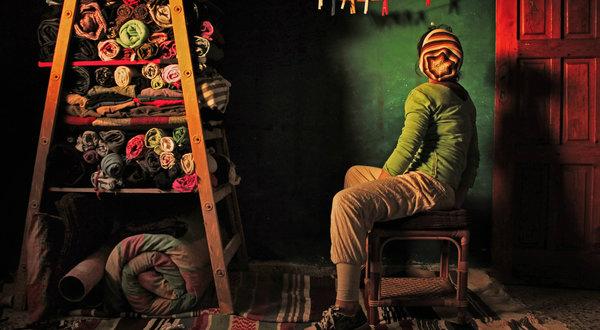After the famous street artist Banksy’s appearance on the ruined streets of Gaza, with graffiti stencils on concrete rubble popping up in criticism of the ‘world’s largest open-air prison’ – including an image of a crying figure wearing a head scarf, a dark scene of children playing on a fairground ride, and a white kitten licking its paws. There is currently another artist highlighting the plight of the region with work that is as internal and personal, as the street artist’s work was external and public in its statement.
Artist Nidaa Badwan’s room is less than 100 square feet, lit by a single window and a bare bulb. She has painted one wall with aquamarine paint and covered another in a patchwork of coloured egg cartons. There is also a mirror, an antique sewing machine and iron, two easels, a large yellow ladder and a gas canister on which she boils water.
The artist has been alienated by Gaza’s restrictive religiosity and constant conflict for some time. The 27-year-old has hardly left the room for more than a year. Within its walls the artist has created her own world, and a striking set of self-portraits to illustrate her own response to the region.
“I wait for the light, everything is beautiful, but only in my room, not in Gaza. I’m ready to die in this room unless I find a better place”, the artist told the New York Times. Many Palestinian youths have tried to escape the poverty in the territory. “You can say now there is another life for me,” she added. “I feel I’m not living here. The project made new windows for me.”
The artist’s project is called “100 Days of Solitude” in homage to Gabriel García Márquez’s landmark novel, though the artist’s isolation has been much longer. Its 14 self-portraits are on display at an East Jerusalem art gallery, whose director, Alia Rayyan, said they evoked the Dutch masters of the 16th and 17th centuries with modern splashes, made more meaningful against the unseen backdrop of chaos outside.
“It’s very bleak and at the same time it’s very beautiful,” Anthony Bruno, director of the French Institute in Gaza, told the New York Times, having spent about $8,000 to produce the exhibit. “Most of the work of Gaza artists is usually very influenced by the conflict, by the occupation, by the siege, by the war, and sometimes it does it in a not-so-subtle-way. Here, if you dig deeper in the meaning of her works, it’s definitely there, but it tries to transcend that.”
 Image: All images courtesy of Nidaa Badwan ©
Image: All images courtesy of Nidaa Badwan ©
Ms. Badwan hung a set of abstract red and blue paintings on a charred wall of the bombed-out Red Crescent Cultural Centre, after Israel’s three-week war with Hamas. In 2012, she was among 40 artists in the show “This Is Also Gaza,” with photographs of a woman’s head covered by a black plastic bag that Samia Halaby, an art historian, commented that the work “express the anguish of life in Gaza.”
On Nov. 18, 2013, the artist confirmed to the New York Times that she was harassed by Hamas officers while helping with a youth arts program. They questioned why she was standing with men. They went on to chastise her for wearing those jean overalls and made her sign a paper promising not to go outside without wearing loosely fitting, traditional Islamic clothing.
“I told them I’m an artist; they said, ‘What does this mean?’ ” she recalled. “I said, ‘I make films and videos.’ They said, ‘We don’t know what you are talking about, and what do you wear? Why do you look so different?’ They hit me.”
“Slowly, slowly, I started to love isolation,” she explained. “It’s not a disease. It healed me. I used to knock on many doors in Gaza to enter the world I want to live in, but there is no door,” she explained. “I love cinema; there is no cinema in Gaza. I paint; there are no galleries to show what I paint. A woman and an artist at the same time — this is a catastrophe.” The artist withdrew, deleting many locals from her Facebook account, and focusing instead on the creation of her internal world. “Everything that is not art, I try to transform it into art,” she said.
 Image: All images courtesy of Nidaa Badwan ©
Image: All images courtesy of Nidaa Badwan ©
The artist made only one artwork: a photo of herself in short sleeves against the aquamarine wall, sexily looking off to the side as she pours what looks like blood over her head as part of a Palestinian-solidarity riff on the “ice bucket challenge.” as a response to last summer’s 50-day battle between Hamas and Israel, Ms. Badwan stayed home when her parents and neighbours fled the shelling.
The artist is currently exhibiting at Al Hoash Gallery in Jerusalem until March 5, next heads to the West Bank cities of Nablus, Ramallah, Hebron and Bethlehem, with hopes for Paris and Berlin.
The artist added that she had left the house only twice in 15 months: on Jan. 22, to view the opening of her exhibit via Skype at a Gaza City hotel, and then two days later to see a doctor. Badwan recalled “I ordered a taxi and the car was black, the windows were closed, nobody could see me,” she said. “I closed my eyes. I put on headphones — ‘What a Wonderful World.’ My head was down. I didn’t want to break my isolation. I didn’t want to see Gaza.”
All images courtesy of Nidaa Badwan ©

